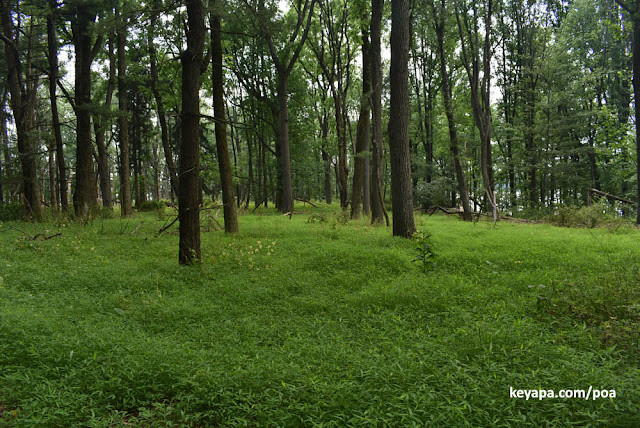 |
| A carpet of Microstegium vimineum covers the forest floor in Merrill Creek Reservoir |
There were very few hikers in either trail, and the Shoreline Trail in particular seemed relatively unmaintained, with grass frequently on the ground and understory vegetation crowding hikers from the sides. Although there were some nice views of the lake at certain spots, on the whole the tight narrow paths in some parts of the trails made for uneasy going, and we later found out my wife had a deer tick biting her shoulder!
 |
| The distinctive bamboo-like leaves of M. vimineum, with the distinctive line of silvery hairs along the midline |
Microstegium vimineum (or Stiltgrass) has small bamboo-like leaves with a distinctive silvery line along the midline. It is a low-growing grass species that has been pushing aside native vegetation in shady forested areas, and when people talk about this invasive, one sometimes has visions of immense swaths of forest understory clothed in its delicate green blades. Instead of a varied mix of other grasses and low herbaceous plants, one sees a monoculture that has strangled other competitors and holds sway over vast tracts of parkland and virgin woods.
 |
| Microstegium vimineum lines a hiking trail in Merrill Creek Reservoir |
It's true that there are large areas which have undulating carpets of stiltgrass covering the forest floor, and there are many more cases where the hiking paths are lined on both sides by this invasive. But for much of the time M. vimineum is represented by perhaps only a few specimens whose small forms are lost in the riotous tangle of other understory vegetation.
This of course does not mean that we should become lax about protecting the biodiversity of our parks and forests. From all indications this invasive is expanding its range, and just because it does not completely dominate entire forest understories right now does not mean it won't do so in the near future.
The spread of this invasive is aided partly by mechanical means, including through the clothing of passing hikers. So if you encounter this species during one of your hikes in the woods, be sure not to inadvertently contribute to its spread by brushing against the plants.
No comments:
Post a Comment